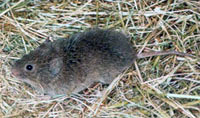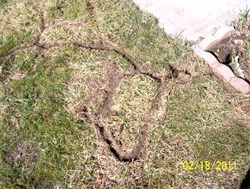Voles
 Whenever we have an extended period of time with snow on the ground the calls come in shortly after the snow melts from people trying to figure out what is up with all the trails in their lawn. The trails are normally located adjacent to the landscaped portion of the yard, next to the home or other building. These trails differ from mole runways as they are just pathways at ground level instead of the pushed up ridges associated with moles.
Whenever we have an extended period of time with snow on the ground the calls come in shortly after the snow melts from people trying to figure out what is up with all the trails in their lawn. The trails are normally located adjacent to the landscaped portion of the yard, next to the home or other building. These trails differ from mole runways as they are just pathways at ground level instead of the pushed up ridges associated with moles.
The culprit is a prairie vole. Voles will cut the grass blades at ground level and then maintain the trail by constantly travelling back and forth over the pathway. With the snow serving as protection from predators the voles seize the opportunity to expand their territory into the lawn. Prairie voles are stocky rodents with a short tail, 5.5 – 7 inches in length with a grizzled looking grayish/brown fur with black tips.
 Voles are active year round and eat a wide variety of grasses, forbs, bark and will store seeds and bulbs in the fall. In the fall and winter they can cause severe damage to tree seedlings by girdling.
Voles are active year round and eat a wide variety of grasses, forbs, bark and will store seeds and bulbs in the fall. In the fall and winter they can cause severe damage to tree seedlings by girdling.
Voles
- Breed throughout the year
- Have 3 - 4 litters per year
- Average 3-5 young per litter
- Have a gestation period of 21 days
- Are weaned at 21 days
- Breed at 35 days of age
Small populations of voles may be controlled using mouse traps. Larger populations are normally controlled using the toxicant zinc phosphide in a bait form. The bait is dropped into the burrow openings to eliminate the chance for a non-target animal or child from ingesting the bait.
For more detailed information on voles and their control please click the link: Vole Control in Lawns and Landscapes
